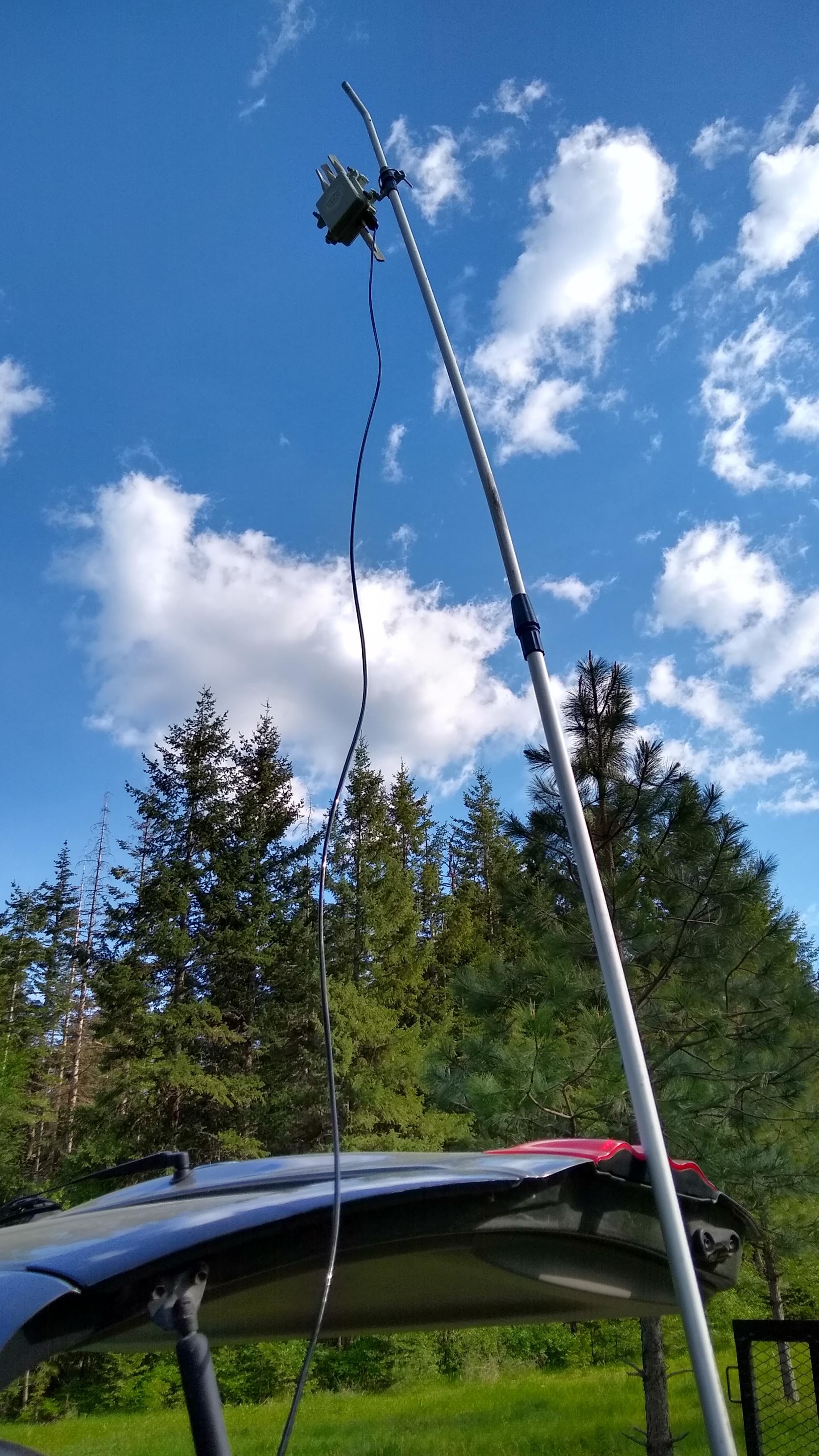I don't usually have much luck out of the gates with any project, but this one was a breeze.
My first test was as simple as possible - parked at the remote site, I threw the hotspot on the roof of the car and plugged the POE injector into the inverter. The WiFi list on my phone was completely empty until one lonely AP showed up. I was able to connect without any issues and make calls, text, and surf the web. Not exactly blazing fast, but it worked with zero optimization. Badda-bing!
The second test was slightly more involved. I put the hotspot on the end of an extensible pole - a roof rake for snow removal - and lofted the unit up about 3 meters AGL.

I wanted to test if height made any difference in connection speed, and to test the range of the WiFi around the property. Speed was definitely better, at least according to my Speedtest app - 2.59-Mbps downloads while up on the pole versus 1.66-Mbps on the roof. I suspect I can improve that considerably by replacing the stock omnidirectional LTE antennas with log-periodic dipole array (LDPA) diversity antennas, but more on that later.
As for WiFi coverage, I was pleasantly surprised. We walked east from the hotspot for quite a way, over 230 meters, before dipping down below the local horizon and losing the signal in the weeds. To the north we were able to range almost to the property line, about 140 meters, and to the west over 100 meters and just about to the gate on the county road. That's a big bubble of WiFi, much better than a typical consumer-grade router can do. Assuming an elliptical pattern, it covers about 62% of the property - again, with almost no optimization. Mounted on a permanent pole with better omnidirectional MIMO WiFi antennas, and this thing would be able to supply WiFi to the neighbors. If there were any.
Next step - measuring the power required by the hotspot and designing a solar array to power it.
 Dan Maloney
Dan Maloney
Discussions
Become a Hackaday.io Member
Create an account to leave a comment. Already have an account? Log In.
Wow, that seems like a lot. The router is supposed to draw only 3 watts, although that remains to be tested. I was thinking more along the lines of a small panel and battery, maybe 20 watts or so, just enough to keep it running overnight. I doubt I'd be able to build anything reasonable that'll stay alive in the long, dark winters near the 49th parallel. Although I will be building out a larger solar system for a cabin eventually. But that's a stretch goal.
Are you sure? yes | no
If you aren't trying to keep it alive during long dark stretches, then you should definitely be able to get away with a panel in the 20 - 30 watt range.
I remember a few years back looking at running a small x86 server on solar (this was before the Raspberry Revolution), and the numbers always started going pear-shaped when I started to consider the effects of even a single stormy day.
Are you sure? yes | no
3W will probably be it's max draw when running wifi and cell phone comms at full whack. If you dont use it too much, dont download too many episodes of 'Outsiders' https://www.youtube.com/watch?v=u7K0ecPen2c from Netflix, you'll use a fraction of that power whilst ticking over, with a n occasional burst when it checks it's connection with base station.
Are you sure? yes | no
Yeah, I'm going to power the thing up on the bench and monitor the current draw over time. Not sure how, though - perhaps I can rig something with my oscilloscope and a shunt resistor.
Are you sure? yes | no
Yes use scope and shunt, you might have to play about with the value of the shunt if it does not work first time.
Are you sure? yes | no
Worried about blowing up the scope since it's mains powered. Think I'll just got with an INA219 current sensor and throw together a quick Arduino data logger. https://www.amazon.com/HiLetgo-INA219-Bi-directional-Current-Breakout
Are you sure? yes | no
Great project! My guess would be 250 w solar array for December / January.
Are you sure? yes | no